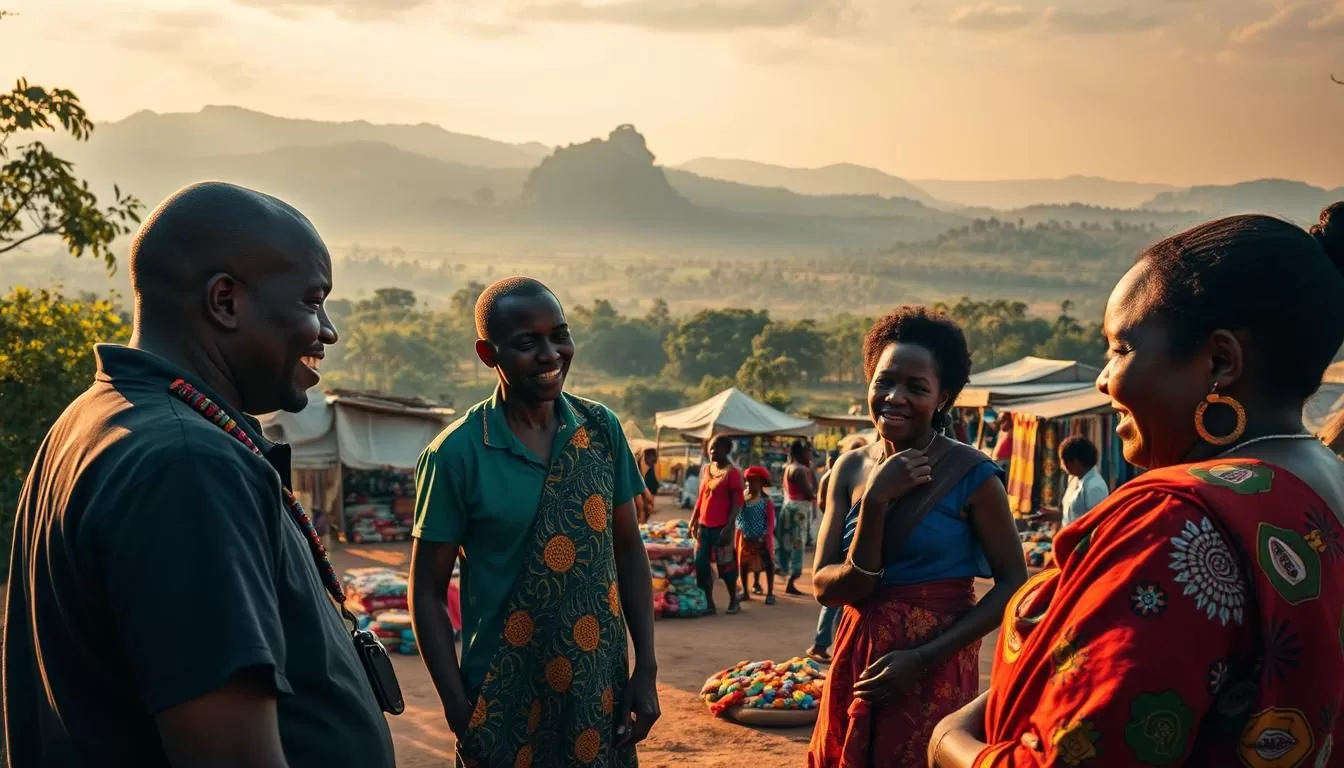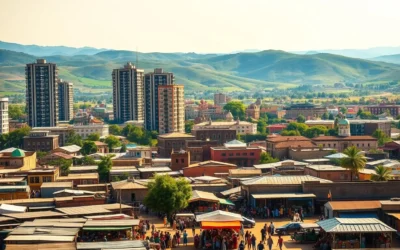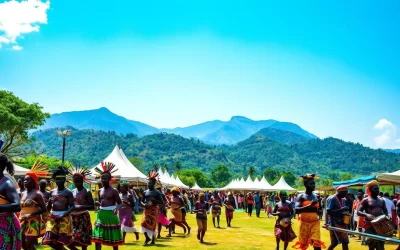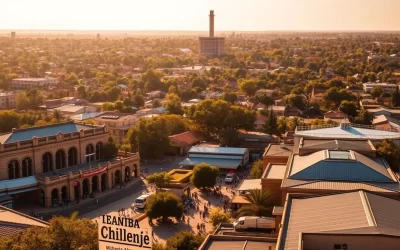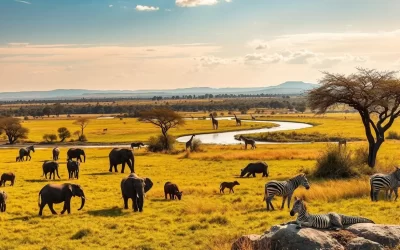Zambia is a country with a rich linguistic tapestry. English serves as the official language, used in government, education, and business. While only 2% of the population speaks it as a first language, it is the most common second language.
Indigenous languages play a vital role in daily life. Bemba, Nyanja, and Tonga are among the most widely spoken. Bemba, for example, is the primary language in the Copperbelt region. Nyanja dominates in Lusaka and surrounding areas.
This linguistic diversity reflects the cultural richness of the area. Understanding these languages offers insight into the nation’s identity and traditions. Explore how language shapes Zambia’s unique character.
Introduction to Zambia’s Linguistic Diversity
Exploring the language landscape reveals a rich cultural heritage. This region is home to seventy-three ethnic groups, each speaking related languages. The government has divided the area into seven linguistic zones for administrative purposes.
An Overview of the Language Landscape
Seven native languages are officially recognized as regional languages. These include Bemba, Nyanja, Tonga, Lozi, Luvale, Lunda, and Kaonde. Each language dominates specific provinces, reflecting the population’s distribution.
For example, Bemba serves as the lingua franca in the Northern, Luapula, and Copperbelt regions. Nyanja is prevalent in Lusaka and Eastern areas, while Tonga is dominant in the Southern Province.
Population, Census Data, and Regional Insights
Census data provides a detailed look at language usage. Bemba is spoken by 35% of the population as either a first or second language. Nyanja follows closely at 37%, while Tonga is used by 25%.
Here’s a breakdown of language distribution by province:
| Province | Primary Language |
|---|---|
| Northern, Luapula, Copperbelt | Bemba |
| Lusaka, Eastern | Nyanja |
| Southern | Tonga |
| Western | Lozi |
Post-independence policies have played a key role in shaping language evolution. Increased mobility and employment practices have impacted local languages, especially in urban centers.
Understanding these patterns offers a deeper appreciation of the region’s cultural identity. The interplay between official and indigenous languages highlights their societal importance.
Historical Evolution of Zambia’s Languages
The linguistic history of this region is deeply rooted in its pre-colonial past. Long before external influences, indigenous communities thrived with their own dialects and oral traditions. These languages were central to daily life, education, and cultural identity.

Pre-Colonial Linguistic Roots
Traditional languages were shaped by the Bantu settlers who arrived in the 4th century. They introduced agriculture and copper mining, which became integral to the region’s development. Oral traditions played a key role in passing down knowledge and preserving cultural heritage.
In rural areas, these languages remained dominant. Communities relied on them for communication, storytelling, and education. This deep connection ensured their survival despite external changes.
The Impact of Colonial Rule on Language Adoption
Colonial rule brought significant shifts in language policy. English was introduced as the official language, used in administration and formal education. This change aimed to unify diverse communities under a single linguistic framework.
Despite this, rural areas maintained strong ties to indigenous languages. These dialects continued to thrive in local settings, showcasing the resilience of traditional cultures.
The balance between historical traditions and the introduction of an official language highlights the region’s adaptability. This evolution reflects the dynamic interplay between preservation and progress.
Official Language of Zambia: Zambian English
Zambian English reflects a unique blend of global and local influences. It has evolved to incorporate distinctive grammatical features shaped by indigenous languages. This adaptation makes it a fascinating subject for linguistic study.
Distinctive Features and Usage
Zambian English often simplifies phrasal verbs and omits certain object pronouns. These changes are influenced by the structure of local languages, making it easier for a person to communicate in diverse settings.
In urban areas, you’ll notice a mix of formal and informal expressions. This blend is particularly evident in the northern provinces, where traditional language families have a strong impact.
The Role of English in Government and Business
English serves as the primary language for government operations and business transactions. It ensures clear communication across different regions and communities.
In the business sector, fluency in English is often a key requirement. This trend highlights its importance in fostering economic growth and professional opportunities.
| Setting | Language Use |
|---|---|
| Government | Official documents, meetings |
| Business | Contracts, negotiations |
| Education | Instruction, textbooks |
The interplay between traditional languages and English continues to shape its evolution. Understanding this dynamic offers insight into the cultural and linguistic identity of the region.
Zambia: Official and widely spoken languages
With over 72 indigenous tongues, this area boasts a rich linguistic tapestry. The government acknowledges seven regional languages, which are used in early primary schooling and some official publications. These languages reflect the cultural diversity of the region, offering a glimpse into its vibrant heritage.
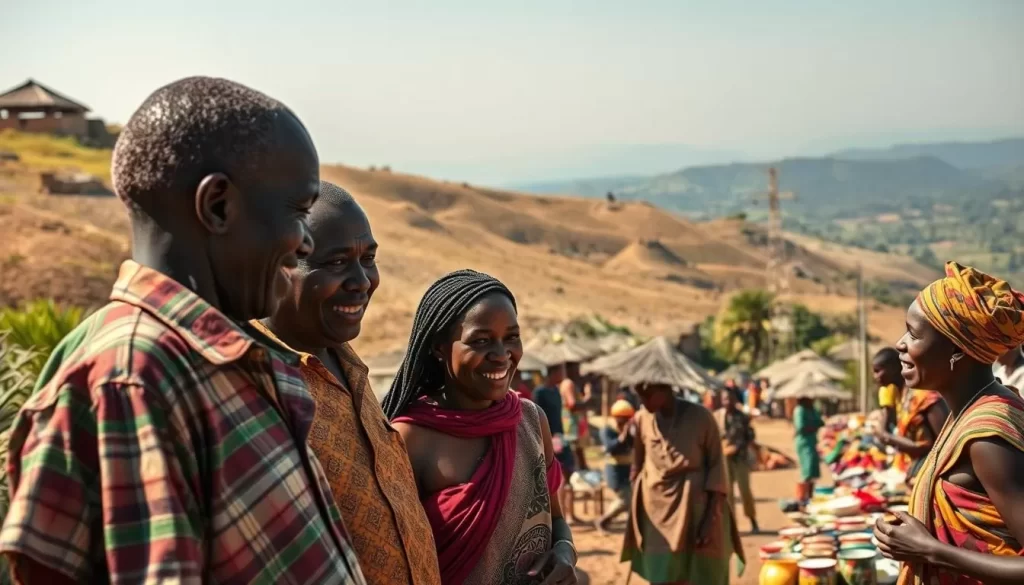
Ethnic groups play a significant role in shaping the language landscape. Each group contributes to the preservation of its unique dialects, ensuring that traditional knowledge and cultural practices are passed down through generations. This grouping of languages highlights the interconnectedness of the region’s communities.
Here’s a quick look at the distribution of major languages:
- Bemba: Spoken by 35% of the population as a first or second language.
- Nyanja: Used by 37% of the population, particularly in urban areas.
- Tonga: Dominant in the Southern Province, with 25% of speakers.
The official recognition of regional languages underscores their importance in education and governance. However, the rich indigenous language landscape remains a cornerstone of cultural identity. Efforts to preserve these languages are vital in maintaining the region’s multicultural fabric.
Understanding the balance between official and indigenous tongues offers insight into the region’s societal dynamics. This linguistic diversity is not just a reflection of its past but also a foundation for its future.
Regional Languages and Their Cultural Significance
The cultural fabric of this region is woven with diverse linguistic threads. Languages like Bemba, Nyanja, and Tonga dominate specific areas, reflecting the population’s distribution. These languages are not just tools for communication but also carriers of history and tradition.
Major Regional Languages and Their Distribution
Bemba is the most widely spoken native language, with approximately 2 million speakers. It dominates the Northern, Luapula, and Copperbelt regions. Nyanja, spoken by 20% of the population, is prevalent in Lusaka and Eastern areas. Tonga, used by 12%, is dominant in the Southern Province.
These languages are deeply rooted in the region’s history. They have evolved over centuries, adapting to social and cultural changes. Their continued use highlights their importance in preserving local identities.
The Use of Regional Languages in Education and Media
Regional languages play a vital role in primary education. They are used in early schooling to help children connect with their cultural roots. This approach fosters a sense of belonging and pride in local traditions.
In media, these languages are widely used in radio, television, and print. This ensures that the majority of the population can access information in their native tongues. Such integration strengthens community bonds and promotes cultural preservation.
Understanding the role of these languages offers insight into the region’s societal dynamics. They are not just means of communication but also pillars of cultural identity.
Indigenous Languages and Dialects in Zambia
The linguistic diversity of this region is a testament to its cultural richness. Over 72 indigenous languages thrive here, each with its own unique dialects. These languages have evolved over centuries, reflecting the deep-rooted traditions of the communities that speak them.

Diversity Among the 72 Indigenous Languages
From the Bemba spoken in the northern regions to the Lozi dominant in the western province, each language carries its own history. Bemba, for instance, is spoken by over 33.5% of the population, making it one of the most widely used. Tonga, another major language, is prevalent in the southern areas, with around 1.33 million speakers.
These languages are not just tools for communication but also repositories of cultural knowledge. They have been passed down through generations, preserving the identity of each community.
The Relationship Between Dialects and Distinct Languages
Dialects often serve as bridges between distinct languages. In urban towns, you’ll notice a blend of formal second language usage and colloquial dialects. This mix is particularly evident in areas like the western province, where traditional languages meet modern influences.
In rural settings, dialects remain closer to their indigenous roots. This contrast highlights the adaptability of these languages over the centuries. Understanding these variations offers a deeper appreciation of the region’s linguistic landscape.
The Role of Language in Zambian Society
Language shapes daily life in unique ways across different settings. In rural areas, indigenous dialects dominate, preserving centuries-old traditions. Urban centers, however, showcase a blend of traditional and modern linguistic forms.
This contrast is evident in census data. For example, Bemba is spoken by 30.1% of the population as a first language, primarily in rural regions. In cities like Lusaka, Nyanja and English are more prevalent, reflecting the influence of migration and globalization.
Language in Rural vs. Urban Settings
In rural provinces, language is deeply tied to cultural identity. Communities rely on indigenous dialects for communication, storytelling, and local governance. These languages serve as a bridge to ancestral heritage, ensuring traditions are passed down through generations.
Urban areas, on the other hand, embrace linguistic diversity. English is widely used in business and education, while regional languages like Nyanja facilitate daily interactionsp>. This blend creates a dynamic linguistic landscape, where traditional and modern forms coexist.
Census statistics highlight these differences. Here’s a breakdown of language use by province:
| Province | Primary Language | Second Language |
|---|---|---|
| Northern | Bemba | English |
| Lusaka | Nyanja | English |
| Southern | Tonga | Bemba |
Language remains a key marker of social identity in both settings. In rural areas, it strengthens community bonds. In urban centers, it fosters inclusivity and adaptability.
Understanding these patterns offers insight into the societal dynamics of the region. For more details, explore this comprehensive guide.
Educational Impact of Multilingualism
Multilingual education plays a pivotal role in shaping literacy and societal participation in the republic. By integrating native tongues into the curriculum, schools foster a deeper connection between students and their cultural heritage.

Language Instruction in Primary Schools
Government policies emphasize teaching in both English and local languages. This approach helps students develop strong communication skills in multiple languages by the end of Grade 9. Research shows that children learn literacy skills more effectively in their native language, which then aids in mastering English.
In 2018, the republic shifted to using local languages as the primary medium of instruction in Grades 1 to 4. This change has led to noticeable improvements in literacy rates.
Enhancing Literacy Through Native Tongues
Using familiar languages in early education creates a supportive learning environment. It allows students to grasp complex concepts more easily, boosting their confidence and academic performance.
For example, in the Chitokoloki zone, schools using Lunda and Luvale as the medium of instruction have seen higher student engagement. This highlights the importance of aligning education with the linguistic background of the speaker.
“Children who learn in their native language develop a stronger foundation for future learning.”
This bilingual approach not only enhances literacy but also strengthens the society by preserving cultural identity. It ensures that every speaker feels valued and included in the educational system.
For more insights on how multilingualism shapes education, explore this comprehensive guide.
Language and Economic Influence in Zambia
Language plays a pivotal role in shaping economic dynamics across diverse regions. In Zambia, the use of multiple dialects and local languages fosters unique business interactions. This multilingual environment has been shaped by historical milestones, such as independence in 1964, which influenced trade and industry communication.
Commerce, Industry, and Multilingual Interactions
In the southern province, dialects like Tonga are widely used in commerce. These local languages help build trust and rapport in business dealings. Studies show that businesses leveraging native dialects often see higher engagement and customer satisfaction.
Post-independence in 1964, English became the primary language for formal business. However, indigenous languages remain crucial in informal settings. This blend of languages ensures effective communication across different sectors.
Here’s a breakdown of language use in key industries:
| Industry | Primary Language | Secondary Language |
|---|---|---|
| Retail | Bemba | English |
| Agriculture | Tonga | Nyanja |
| Mining | English | Bemba |
Language proficiency is directly linked to economic growth. Workers fluent in multiple dialects often have better job opportunities. This trend is particularly evident in urban centers, where multilingualism is highly valued.
“Understanding local dialects is key to unlocking economic potential in diverse regions.”
Efforts to preserve indigenous languages also contribute to economic development. For example, the Zambian government’s plan to introduce Mandarin Chinese in schools aims to enhance international trade relations. This initiative highlights the importance of language in fostering global connections.
To learn more about the role of language in economic growth, explore this comprehensive guide.
Provincial Linguistic Profiles
Each province in Zambia offers a distinct linguistic identity shaped by its cultural and historical influences. From the Bemba-speaking regions in the north to the Nyanja and Lozi areas in the east and west, the diversity is remarkable. Let’s explore these regional linguistic profiles in detail.
Northern and Luapula: Bemba and Related Languages
In the Northern and Luapula provinces, Bemba dominates as the primary language. Over half of the national population speaks Bemba, making it one of the most widely used languages in the country. It serves as the medium of instruction in Grades 1–3 and is taught as a subject up to Grade 12.
Bemba’s linguistic structure includes 20 noun classes and a complex verb system, reflecting its rich cultural heritage. This language coexists with English and Nyanja, showcasing the region’s multilingualism.
Eastern and Western Provinces: Nyanja, Lozi, and Others
The Eastern province is predominantly Nyanja-speaking, while Lozi is widely spoken in the Western province. These languages are integral to daily life and are used in education, media, and local governance.
Nyanja, for instance, is taught in schools and used in mass media, ensuring its preservation and relevance. Lozi, on the other hand, is deeply tied to the cultural identity of the Western region.
Unique Dialects in the Copperbelt and Capital Regions
The Copperbelt and capital regions are linguistic melting pots. Here, unique dialects emerge due to economic activity and urban migration. Bemba remains influential, but local variations add to the linguistic richness.
In the capital, English is widely used in business and education, while indigenous languages like Nyanja facilitate daily interactions. This blend creates a dynamic linguistic landscape.
Understanding these provincial linguistic profiles offers insight into the cultural and social dynamics of the region. For more details, explore this comprehensive guide.
Factors Influencing Language Shifts and Migration
Urban migration has significantly reshaped the way people communicate across different regions. As populations move from rural to urban areas, the languages they bring with them blend into the local linguistic landscape. This shift has led to the evolution of the language spoken in metropolitan centers.
Urban Migration and Its Impact on Language Use
When people migrate to cities, they often adopt the dominant languages of their new environment. This trend is evident in the way widely spoken languages like English and Nyanja have expanded in urban areas. These languages become essential for daily interactions, business, and education.
Migration patterns show that linguistic assimilation is common in urban centers. For example, the Ngoni language has seen a decline as its speakers move to cities and adopt other languages. This change reflects the broader impact of migration on language practices.
Urban areas also attract diverse populations, creating a melting pot of dialects and languages. This diversity enriches the linguistic environment but can also lead to the loss of less dominant languages.
Understanding these shifts helps explain how language spoken in cities evolves. For more insights, explore this comprehensive guide on language and migration.
Conclusion
The linguistic landscape here is a dynamic blend of tradition and modernity. Various forms of communication coexist, each reflecting unique cultural roots. From Bemba to Nyanja, these tongues are closely related yet distinct, showcasing a rich variety of expression.
Historical events and migration have shaped how people use word and dialect. Urban areas often blend traditional and modern languages, while rural regions preserve indigenous speech. This balance highlights the adaptability of communities over time.
Understanding this linguistic diversity offers insight into the cultural fabric of the region. It’s a reminder of how language evolves while staying rooted in heritage. Explore more about Bemba, one of the most influential tongues, to see its impact firsthand.
Appreciating this dynamic environment helps you connect with the region’s identity. Language isn’t just a tool—it’s a bridge to understanding history, culture, and society.
The above is subject to change.
Check back often to TRAVEL.COM for the latest travel tips and deals.
Here are some Tours & Sightseeing suggestions that might pique your interests!
